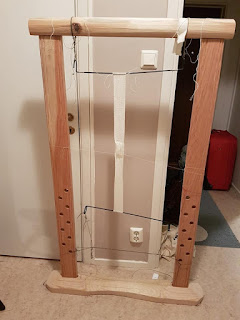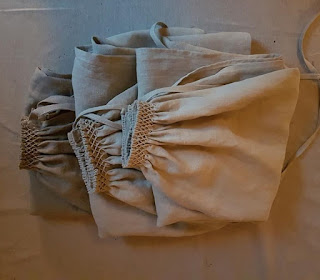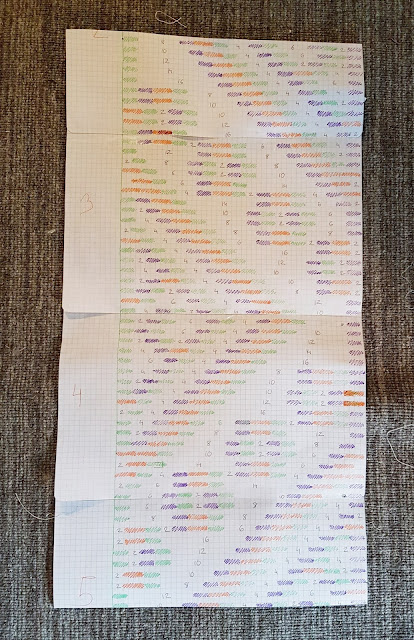During a restoration of the Lengberg castle (East Tyrol, Austria) in 2008 a filled vault was detected below the floorboards. More than 2,700 textile fragment were found in there. Its not unusual to find textile fragments, shoes, and rubble under floorboards in old houses. In my regular job, as building conservation officer, I see it and hear about it all the time. This part of the Lengberg castle was probably finished by 1485 so the finds is most likely predating this. Among the finds there were a couple of sprang woven fragments, in different conditions. They are all made of undyed linen z-spun s-plied two-ply thread.
The largest one is still attached to the garment, a headwear, first thought to be a bra. It consist of four pieces of natural linen. In the middle, from the forehead to the back of the head, is a beautiful piece of sprang. It has a decorative patterns made up by holes. The sprang is 27 cm long.
The sprang in the right down corner. The pictures of the original comes from here.
I normally don´t do 15th century fashion. But I do sprang. And this was to beautiful and intriguing not to try. It would be the most difficult pattern I tried so far. And I can tell you, I almost didn't breathe during the entire time... But I did it!
My sprang frame is a copy of a weavingloom/sprang frame found on the Oseberg ship. Its from the viking age but the frames did´nt change that much. There are paintings with sprang frames from the 16th century looking almost the same. And the look of the frame does not change the look on the sprang possible to make on them. Last time I posted something about sprang I said that the loom/frame was only for weaving. But after that I red the Collingwood book about sprang and he says that the Oseberg ship weaving frame were probably made to do sprang also. And it work just fine for sprang too.
When reading the articles by Beatrix Nutz on the matter I get a bit confused though. They did a copy of the headwear but seems to have used another pattern for the sprang, the tree of life. I dont understand why. By looking at the picture of the garment it is obvious that the design is another. What am I missing? I found the pattern for that design online though, its not in the articles of the remnants.
The chart for the sprang is created by Kristen Hughes at The Sojouring Spinner. But I found it here. Its made up by letters though, and I don´t like to use letters while working, its to small and difficult to see. I want different colours for different twists. So I made up my own from it.
Here is my pattern.
The warp count of the original piece is 120 threads, 60 loops.The pattern is for 108 threads and 54 loops. So not the same exactly. But when looking at the original piece you see that the pattern is wider, a half a repetition is on each side. I don´t know if this is the missing 12 threads. They might be too few to give that much sprang in both ends. I might try that out another time. Its made with a basic interlinking stitch and a white linen thread. I used this thread. It might be a bit thinner than the original one.
The different stitches needed for this piece is not difficult. It is made up by three different kinds, the right-edge stitch, the left-edge stitch and the double stitch. The edge stitches in my pattern is not included, I just makes them without thinking. The plait row is not in the pattern either. Making this sprang you work with two rows, the plait and overplait row. The holes in the pattern are made during a overplait row and between all the overplait rows there are plaits rows. In this case the words can be replaced with even-numbered rows and odd-numbered rows. An overplait row starts with a right-edge stitch, wich is two thread up and one down. And ends with a left-end stitch that is one thread up and two down. In my pattern the right-edge stitch is blue and the left-edge stitch is green. So when a green box turn up in the pattern I know that I should do a left- edge stitch, one down, two up. So, the stitches in not difficult, very basic. The difficulties lay in knowing where I am in the pattern. But I guess that comes from experience.
I created a 70 cm long warp. My aim was for 27 cm, as the original piece. Or is this the length of the tree of light, that they used instead of the original? I dont know, I aimed for 27 cm anyhow.
Sprang is created in the end of the warp, which results in a mirror image in the end of it. So, if you don´t want to connect your piece in the middle you make two in one!
When I have been doing sprang before I have had a lot of supporting sticks. If you make a mistake they help you untwisting rows without the whole thing unravels. But as you can see in the picture above I only using one stick. I tried with a couple from the beginning but I needed to restart because with a lot of sticks I could not get the tension right. The holes became to big. So, I started all over and removed all but one. That was a scary part of this for me. I knew that if I made mistakes and didnt see it before I went on to the next row I needed to unravel the whole thing or live with a mistake in the middle of it. I remade some rows a couple of times, just based on the feeling that something in it was wrong...



And its done! Still in the frame though. And you never know what happens to the tension when taking out of the frame. When taken out of the frame I soaked them in water and left them to dry over night. This is to shape them. If I wanted to make them wider I could have put needles in the corners and it would stay like that when dried.
And this pictures is taken this morning, Dried up and all beautiful. They are 29 cm long and 7,2 wide. If the user wants them in a wider garment that is alright too. They are very flexible.
This sprang can be used as the original, in a headwear. It can also be used between the cups in a bra-dress. The sprang between the cups of the Lengberg bra-dress is gone. For the reconstruction of it another sprang fragment from Lengberg was used, this one from the headwear. According to Beatrix Nuts the sprang between the cups had two purposes; it helped the cups to lay flat and covered the decolletage. When the sprang was done it was shaped to fit the space between the cups by untwisting parts of it. I would suggest that if used in between cups to attache it on the top by stitches so that it is steady, and then very carefully untwist a little bit at the time. Its very easy to untwist to much and no way to undo it.
Do I need to make the headwear now, just to be able to show this of? And whats next, the whole 15th century outfit, to go with the headwear?!
Sources





















































